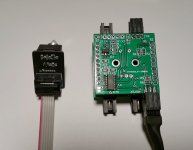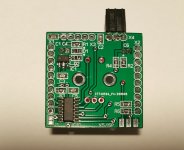Thanks Jean-Paul!
An encoder with stops would indeed do the trick for me and still save us from a display while mechanicaly spotting the volume position at a glance. I guess one just needs an encoder with enough steps to allow a reasonable volume adjustments - I don't need quarter dB steps 🙂. And of course I don't mind if there is still a push button with it for some functions, but important is indeed we get that mechanical and visual feel for volume.
Project anyone?
An encoder with stops would indeed do the trick for me and still save us from a display while mechanicaly spotting the volume position at a glance. I guess one just needs an encoder with enough steps to allow a reasonable volume adjustments - I don't need quarter dB steps 🙂. And of course I don't mind if there is still a push button with it for some functions, but important is indeed we get that mechanical and visual feel for volume.
Project anyone?
You could use a small processor like an AT Tiny 44. Connect a conventional pot wiper with 5v and 0v to each end to one of the analogue to digital inputs and then use a look up table to produce the required output on the general purpose pins.
You can have as many steps as you want, or need.
You can have as many steps as you want, or need.
What will happen when the potentiometer scratches? Isn't a make before break rotary switch not a better option?
What about a simple volume control based around that new promising chip, but for a change one that could replace an existing volume knob in an existing amp?
Would it be that difficult to have just that chip and a very cheap conventonal pot (motorised or not) just acting as command / order, piloting the attenuation of the chip?
It could replace existing volume pots behind knobs and the volume knob position could tell where we are in terms of volume, rather than needing a display or hope for the best if you youngest has turned the endless wheel... it would also be much cheaper that way for those not needing a remote, 50$ being competitive for example.
Just thinking out loud
MFG
Claude
Your idea is interesting for a replacement and should be quite easy to do.
The muse together with a cheap MCU with an embedded ADC and a potentiometer might do the job actually. This is a quick overview but may work and will be cheap. Software easy to do too.
Hopefully... but all this computing and soft is not my software, hence happy to follow... I still believe t would hit a market for those looking for an affordable alternative to a pot.
Stepped attenuator is expensive and can't be motorised unless spending a fortune, all IMHO
Claude
Stepped attenuator is expensive and can't be motorised unless spending a fortune, all IMHO
Claude
Single deck switches are not that expensive. Remote control will be an issue 🙂
The hope is that an encoder with end stop exists.
The hope is that an encoder with end stop exists.
One of these 1PC 1 Pole 24 step Rotary Switch DIY Attenuator Volume Potentiometer | eBay
+ some diodes and a processor with more inputs will work. Only one resistor needed.
+ some diodes and a processor with more inputs will work. Only one resistor needed.
No remote control option :-(
Perhaps not so easy and couldn't find encoders wth stop... my idea unlikely to materialise?
Perhaps not so easy and couldn't find encoders wth stop... my idea unlikely to materialise?
Single deck switches are not that expensive. Remote control will be an issue 🙂
The hope is that an encoder with end stop exists.
To control the muse and all the steps needed especially the new one with 0.25dB, on less that 360 degree rotation for the encoder means that it will be an encoder with high resolution like 512steps.
In theory it could be possible putting two mechanical limit on a normal encoder or the knob and calibrating both ends with the adjustment range of the muse.
Bourns EM14 to Muses adapter
I understand that I may be the only one in the world annoyed enough with the original PEC-11L encoder to go this route, but here are details and gerbers anyway. With this adapter, Bourns EM14 encoder can replace standard encoder in any device.
Adapter PCB can be connected to the Muses volume control using connector at position for additional display (if you don’t use one, and by cutting some traces) or by soldering wires to the corresponding points. If we consider flat cable red marked wire as 1. then corresponding connection points are marked at controller PCB picture. This encoder seems perfect.
I understand that I may be the only one in the world annoyed enough with the original PEC-11L encoder to go this route, but here are details and gerbers anyway. With this adapter, Bourns EM14 encoder can replace standard encoder in any device.
Adapter PCB can be connected to the Muses volume control using connector at position for additional display (if you don’t use one, and by cutting some traces) or by soldering wires to the corresponding points. If we consider flat cable red marked wire as 1. then corresponding connection points are marked at controller PCB picture. This encoder seems perfect.
Attachments
Using a potentiometer to control the muses chip would transfer the poor synchronization of the potentiometer to the muses chip.
I do not understand the whole discussion. You want the high quality of the Muses chip and then you make sure that you can't use it?
Who uses the whole rotation range of a potentiometer? With me, maybe 25 to 40% are used. I have some customers who have bought exactly this potentiometer so that you can fine-tune a small part of the rotation range.
A volume change from 0 to 100 in a 270 degree rotation can be easily programmed with the appropriate software. So I have implemented this solution in my software.
Who uses the whole rotation range of a potentiometer? With me, maybe 25 to 40% are used. I have some customers who have bought exactly this potentiometer so that you can fine-tune a small part of the rotation range.
A volume change from 0 to 100 in a 270 degree rotation can be easily programmed with the appropriate software. So I have implemented this solution in my software.
Hi ClaudeG,
If you use push buttons for control, you have at least compensated for the poor synchronisation of the standard potentiometers.
But you still need a microprocessor and three different voltages.
If you use push buttons for control, you have at least compensated for the poor synchronisation of the standard potentiometers.
But you still need a microprocessor and three different voltages.
Hello Frank,
Are you referring to my post or it is a late comment on previously discussed idea of using a potentiometer with Muses chip?
If so, my solution is not a potentiometer but 64 pulses per revolution optical encoder, as explained previously:
https://www.diyaudio.com/forums/ana...s-72320-electronic-volume-52.html#post6396535
Are you referring to my post or it is a late comment on previously discussed idea of using a potentiometer with Muses chip?
If so, my solution is not a potentiometer but 64 pulses per revolution optical encoder, as explained previously:
https://www.diyaudio.com/forums/ana...s-72320-electronic-volume-52.html#post6396535
Hi tombo56,
This was only a contribution to the previous discussion.
I took a look at the encoder. Really a nice piece. But with 25€ it is not really cheap.
I will order a part. It should be possible to integrate this via software, so that no additional hardware is necessary.
I am quite satisfied with my changeable step size.
(Muses 72320)
This was only a contribution to the previous discussion.
I took a look at the encoder. Really a nice piece. But with 25€ it is not really cheap.
I will order a part. It should be possible to integrate this via software, so that no additional hardware is necessary.
I am quite satisfied with my changeable step size.
(Muses 72320)
But in fact I have become curious. I will try to program a software which is controlled by a standard pot.
Are there still suggestions for such a solution?
Are there still suggestions for such a solution?
A standard pot is not really a good solution.
Noise at ADC In can toggle the output volume.
Aging, disturbances from installation etc. can increase this behavior.
Direct mapping from ADC should be avoided.
Frank, you wrote that Muses increase the resolution. Nobody forces you to implement the higher resolution. Cut off the LSB and you will have the 0,5dB steps you know from the 72320 😉
BTW: Actually I build a new controller board with a STM32 and many features like conventional pot, programmable steps, optional input channel switching, Muses 72320 or 72323 option...
Noise at ADC In can toggle the output volume.
Aging, disturbances from installation etc. can increase this behavior.
Direct mapping from ADC should be avoided.
Frank, you wrote that Muses increase the resolution. Nobody forces you to implement the higher resolution. Cut off the LSB and you will have the 0,5dB steps you know from the 72320 😉
BTW: Actually I build a new controller board with a STM32 and many features like conventional pot, programmable steps, optional input channel switching, Muses 72320 or 72323 option...
But in fact I have become curious. I will try to program a software which is controlled by a standard pot.
Are there still suggestions for such a solution?
A stepped "make-before-break" attenuator would be a better choice I guess. You don't want any noise/crackling to have influence on the output level.
- Home
- Source & Line
- Analog Line Level
- MUSES 72320 electronic volume


